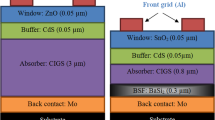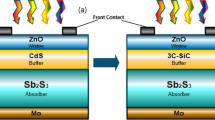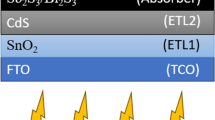Abstract
This paper aims in a simulation work of a novel hybrid heterostructure based on carbon nanotubes as absorber layer with its unique electronic properties in semiconductor technology, and copper barium tin sulfide (CBTS) compound as a back surface field. Cell optimization was investigated in SCAPS–1D software for the architectures ITO/CdS/SWCNTs and ITO/CdS/SWCNTs/CBTS. The device performance and the influence of different materials parameters such as thickness, carrier concentration, and defect density are analyzed in this article. After adding the BSF layer and optimized physical parameters, promising results were achieved with PCE of 30.92%, Voc of 0.83 V, Jsc of 43.47 mA/cm2, and FF of 86.18%.











Similar content being viewed by others
Abbreviations
- µn (\({\mathrm{cm}}^{2}\)/Vs):
-
Electron mobility
- µp (\({\mathrm{cm}}^{2}\)/Vs):
-
Hole mobility
- \({\mathrm{N}}_{\mathrm{D}}\) (\({\mathrm{cm}}^{-3}\)):
-
Shallow uniform donor density
- \({\mathrm{N}}_{\mathrm{A}}\) (\({\mathrm{cm}}^{-3}\)):
-
Shallow uniform acceptor density
- Ve(cm/s):
-
Electron thermal velocity
- Vh(cm/s):
-
Hole thermal velocity
- Nt (\({\mathrm{cm}}^{-3}\)):
-
Defect density
- \(\mathrm{\varphi }(\mathrm{ev})\) :
-
Metal work function
- \(\mathrm{Se}({~}^{\mathrm{cm}}\!\left/ \!{~}_{\mathrm{s}}\right.)\) :
-
Surface recombination velocity for electrons
- \(\mathrm{Sh}({~}^{\mathrm{cm}}\!\left/ \!{~}_{\mathrm{s}}\right.)\) :
-
Surface recombination velocity for holes
- V oc (V) :
-
Open circuit voltage
- J sc (mA/cm 2 ) :
-
Short circuit current density
- Q e (%) :
-
Quantum efficiency
- Rs ( \({{\varvec{\Omega}}.\mathbf{c}\mathbf{m}}^{2})\) :
-
Series resistance
- R sh ( \({{\varvec{\Omega}}.\mathbf{c}\mathbf{m}}^{2})\) :
-
Shunt resistance
- W(µm) :
-
Thickness
- E g (eV) :
-
Band gap
- χ (eV) :
-
Electron affinity
- ε r :
-
Dielectric permittivity (relative)
- N c ( \({\mathbf{c}\mathbf{m}}^{-3}\) ) :
-
CB effective density of states
- N v ( \({\mathbf{c}\mathbf{m}}^{-3}\) ) :
-
VB effective density of states
- SWCNTs:
-
Single walled carbon nanotubes
- CdS:
-
Cadmium sulfide
- ITO:
-
Indium tin oxide
- CBTS:
-
Copper barium tin sulfide
- WT:
-
Working temperature
- PCE(ɳ(%)) :
-
Power conversion efficiency
- BSF :
-
Back surface field
- TCO :
-
Transparent conductive oxide
- FF(%) :
-
Fill factor
References
Tifidat K, Maouhoub N, Benahmida A (2021) An efficient numerical method and new analytical model for the prediction of the five parameters of photovoltaic generators under non-STC conditions. E3S Web Conf 297:01034. https://doi.org/10.1051/e3sconf/202129701034
Ghobadi A, Yousefi M, Minbashi M, Kordbacheh AHA, Abdolvahab AH, Gorji NE (2020) Simulating the effect of adding BSF layers on Cu2BaSnSSe3 thin film solar cells. Opt Mater 107:109927. https://doi.org/10.1016/j.optmat.2020.109927
Bae SH, Zhao H, Hsieh YT, Zuo L, De Marco N, Rim YS, Li G, Yang Y (2016) Printable solar cells from advanced solution-processible materials. Chem 1:197–219. https://doi.org/10.1016/j.chempr.2016.07.010
Meher SR, Balakrishnan L, Alex ZC (2016) Analysis of Cu2ZnSnS4/CdS based photovoltaic cell: a numerical simulation approach. Superlattices Microstruct 100:703–722. https://doi.org/10.1016/j.spmi.2016.10.028
Wang S, Zhang L, Zhang Z, Ding L, Zeng Q, Wang Z, Liang X, Gao M, Shen J, Xu H, Chen Q, Cui R, Li Y, Peng LM (2009) Photovoltaic effects in asymmetrically contacted CNT barrier-free bipolar diode. J Phys Chem C 113:6891–6893. https://doi.org/10.1021/jp901282h
Wang F, Matsuda K (2019) Applications of carbon nanotubes in solar cells. Springer Int Publ. https://doi.org/10.1007/978-3-319-92917-0_20
Pradhan B, Batabyal SK, Pal AJ (2006) Functionalized carbon nanotubes in donor/acceptor-type photovoltaic devices. Appl Phys Lett 88:1–4. https://doi.org/10.1063/1.2179372
Wieland L, Li H, Rust C, Chen J, Flavel BS (2021) Carbon nanotubes for photovoltaics: from lab to industry. Adv Energy Mater 11 https://doi.org/10.1002/aenm.202002880
Kymakis E, Amaratunga GAJ (2005) Carbon nanotubes as electron acceptors in polymeric photovoltaics. Rev Adv Mater Sci 10:300–305
Xosrovashvili G, Gorji NE (2014) Numerical simulation of carbon nanotubes/GaAs hybrid PV devices with AMPS-1D. Int J Photoenergy 2014 https://doi.org/10.1155/2014/784857
Wang F, Kozawa D, Miyauchi Y, Hiraoka K, Mouri S, Ohno Y, Matsuda K (2015) Considerably improved photovoltaic performance of carbon nanotube-based solar cells using metal oxide layers. Nat Commun 6:1–7. https://doi.org/10.1038/ncomms7305
Yang Y, Chen H, Zheng X, Meng X, Zhang T, Hu C, Bai Y, **ao S, Yang S (2017) Ultrasound-spray deposition of multi-walled carbon nanotubes on NiO nanoparticles-embedded perovskite layers for high-performance carbon-based perovskite solar cells. Nano Energy 42:322–333. https://doi.org/10.1016/j.nanoen.2017.11.003
Al-Bahrani MR, Ahmad W, Sen Ruan S, Yang Z, Cheng Z, Gao Y (2015) Layer-by-layer deposition of CNT- and CNT+ hybrid films for platinum free counters electrodes of dye-sensitized-solar-cells. RSC Advances 5:95551–95557. https://doi.org/10.1039/c5ra15939c
Sgobba V, Guldi DM (2008) Carbon nanotubes as integrative materials for organic photovoltaic devices. J Mater Chem 18:153–157. https://doi.org/10.1039/b713798m
Khan D, Ali Z, Asif D, Kumar Panjwani M, Khan I (2021) Incorporation of carbon nanotubes in photoactive layer of organic solar cells. Ain Shams Eng J 12:897–900. https://doi.org/10.1016/j.asej.2020.06.002
Khan D, Tan ZA, Khan I, Panjwani MK (2018) A review of the challenges and possibilities of using carbon nanotubes in organic solar cells. Sci Adv Mater 10:747–760. https://doi.org/10.1166/sam.2018.3260
Von Roos O (1978) A simple theory of back surface field (BSF) solar cells. J Appl Phys 49:3503–3511. https://doi.org/10.1063/1.325262
Ge J, Koirala P, Grice CR, Roland PJ, Yu Y, Tan X, Ellingson RJ, Collins RW, Yan Y (2017) Oxygenated CdS buffer layers enabling high open-circuit voltages in earth-abundant Cu2BaSnS4 thin-film solar cells. Adv Energy Mater 7 https://doi.org/10.1002/aenm.201601803
Shin D, Saparov B, Zhu T, Huhn WP, Blum V, Mitzi DB (2016) BaCu2Sn(S, Se)4: earth-abundant chalcogenides for thin-film photovoltaics. Chem Mater 28:4771–4780. https://doi.org/10.1021/acs.chemmater.6b01832
Khattak YH, Baig F, Toura H, Beg S, Soucase BM (2019) Efficiency enhancement of Cu2BaSnS4 experimental thin-film solar cell by device modeling. J Mater Sci 54:14787–14796. https://doi.org/10.1007/s10853-019-03942-6
Burgelman M, Nollet P, Degrave S (2000) Modelling polycrystalline semiconductor solar cells. Thin Solid Films 361:527–532. https://doi.org/10.1016/S0040-6090(99)00825-1
Ahmmed S, Aktar A, Hossain J, Ismail ABM (2020) Enhancing the open circuit voltage of the SnS based heterojunction solar cell using NiO HTL. Sol Energy 207:693–702. https://doi.org/10.1016/j.solener.2020.07.003
Erkan ME, Chawla V, Scarpulla MA (2016) Reduced defect density at the CZTSSe/CdS interface by atomic layer deposition of Al2O3 J Appl Phys 119 https://doi.org/10.1063/1.4948947.
Li Z, Saini V, Dervishi E, Kunets VP, Zhang J, Xu Y, Biris AR, Salamo GJ, Biris AS (2010) Polymer functionalized n-type single wall carbon nanotube photovoltaic devices. Appl Phys Lett 96 https://doi.org/10.1063/1.3284657
Wei J, Jia Y, Shu Q, Gu Z, Wang K, Zhuang D, Zhang G, Wang Z, Luo J, Cao A, Wu D (2007) Double-walled carbon nanotube solar cells. Nano Lett 7:2317–2321. https://doi.org/10.1021/nl070961c
Al-Hattab M, Moudou L, Khenfouch M, Bajjou O, Chrafih Y, Rahmani K (2021) Numerical simulation of a new heterostructure CIGS/GaSe solar cell system using SCAPS-1D software. Sol Energy 227:13–22. https://doi.org/10.1016/j.solener.2021.08.084
Biplab SRI, Ali MH, Moon MMA, Pervez MF, Rahman MF, Hossain J (2020) Performance enhancement of CIGS-based solar cells by incorporating an ultrathin BaSi2 BSF layer. J Comput Electron 19:342–352. https://doi.org/10.1007/s10825-019-01433-0
Sarker S, Islam MT, Rauf A, Al Jame H, Jani MR, Ahsan S, Islam MS, Nishat SS, Shorowordi KM, Ahmed S (2021) A SCAPS simulation investigation of non-toxic MAGeI3-on-Si tandem solar device utilizing monolithically integrated (2-T) and mechanically stacked (4-T) configurations. Solar Energy 225:471–485. https://doi.org/10.1016/j.solener.2021.07.057
Kaminski A, Vandelle B, Fave A, Boyeaux JP, Nam LQ, Monna R, Sarti D, Laugier A (2002) Aluminium BSF in silicon solar cells. Sol Energy Mater Sol Cells 72:373–379. https://doi.org/10.1016/S0927-0248(01)00185-4
Kohara N, Nishiwaki S, Hashimoto Y, Negami T, Wada T (2001) Electrical properties of the Cu(In, Ga)Se2/MoSe2/Mo structure. Sol Energy Mater Sol Cells 67:209–215. https://doi.org/10.1016/S0927-0248(00)00283-X
Yang X, Chen B, Chen J, Zhang Y, Liu W, Sun Y (2018) ZnS thin film functionalized as back surface field in Si solar cells. Mater Sci Semicond Process 74:309–312. https://doi.org/10.1016/j.mssp.2017.08.011
Guirdjebaye N, Ouédraogo S, TeyouNgoupo A, MbopdaTcheum GL, Ndjaka JMB (2019) Junction configurations and their impacts on Cu(In, Ga)Se2 based solar cells performances. Opto-Electron Rev 27:70–78. https://doi.org/10.1016/j.opelre.2019.02.001
Heriche H, Rouabah Z, Bouarissa N (2017) New ultra thin CIGS structure solar cells using SCAPS simulation program. Int J Hydrogen Energy 42:9524–9532. https://doi.org/10.1016/j.ijhydene.2017.02.099
Bouich A, Hartiti B, Ullah S, Ullah H, Touhami ME, Santos DMF, Mari B (2019) Experimental, theoretical, and numerical simulation of the performance of CuIn x Ga (1–x) S 2 -based solar cells. Optik 183:137–147. https://doi.org/10.1016/j.ijleo.2019.02.067
van Dyk EE, Meyer EL (2004) Analysis of the effect of parasitic resistances on the performance of photovoltaic modules. Renew Energy 29:333–344. https://doi.org/10.1016/S0960-1481(03)00250-7
Acknowledgements
The authors are grateful to Mr. Marc Burgelman of the University of Gent in Belgium for supplying SCAPS 1-D simulation software, and they thank everyone who supported this research.
Author information
Authors and Affiliations
Corresponding author
Ethics declarations
Competing interests
The authors declare no competing interests.
Conflict of Interest
The goal of this paper is to simulate a novel hybrid heterostructure based on Carbon Nanotubes as the absorber layer, which has unique electrical features in semiconductor technology, this is the novelty of this work because this material have not been studied widely in this domain although its great properties and it had given interesting results.
Additional information
Publisher's note
Springer Nature remains neutral with regard to jurisdictional claims in published maps and institutional affiliations.
Rights and permissions
Springer Nature or its licensor holds exclusive rights to this article under a publishing agreement with the author(s) or other rightsholder(s); author self-archiving of the accepted manuscript version of this article is solely governed by the terms of such publishing agreement and applicable law.
About this article
Cite this article
Oublal, E., Ait Abdelkadir, A. & Sahal, M. High performance of a new solar cell based on carbon nanotubes with CBTS compound as BSF using SCAPS-1D software. J Nanopart Res 24, 202 (2022). https://doi.org/10.1007/s11051-022-05580-7
Received:
Accepted:
Published:
DOI: https://doi.org/10.1007/s11051-022-05580-7




